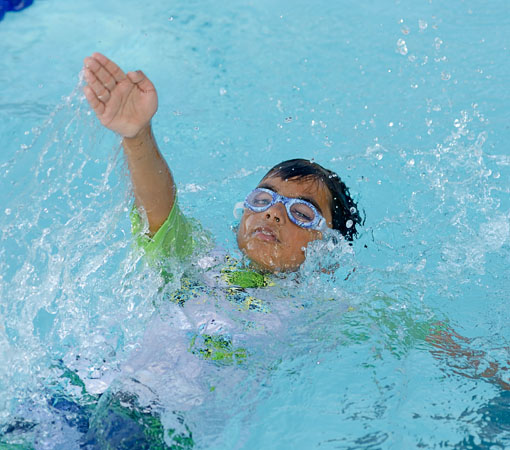BACKSTROKE TIPS
Get back! Here are some tips to keep in mind when you’re swimming backstroke:
- START: Streamline with a dolphin kick underwater.
- HEAD AND BODY POSITION: Your head should be straight up, not moving, with your eyes looking at the sky. Arch your back so your hips and stomach are at the surface. Get your tummy up!
- KICK: You cannot swim backstroke without a good kick. Use strong, fast flutter kicks, and keep your toes pointed.
- SHOULDERS AND HIPS: Rotate your shoulders and hips side-to-side with each arm pull. In backstroke, you spend a lot of time on your side!
- ARMS: Your pinky should enter the water first to start your underwater pull, which should be an “S-curve” with bent arms.
- FLIP TURN: If you are racing a 50-yard event, remember that your flip turn must be done in one continuous motion, with no more than one “freestyle” stroke before you turn.
- FINISH: You must touch the wall on your back. Don’t look for the wall – finish hard!

Official Rules for Backstroke
START
- Your toes must be below the surface of the water at the start.
- You must be on your back at the start of each lap.
TURNS
- As you approach the wall, you may flip onto your stomach and take a single forward (“freestyle”) pull before starting the turning motion.
- The turn must be done in a continuous motion.
- You must push off the wall on your back.
FINISH
- You must touch the wall while on your back.
Backstroke Drills
6-Kick
- Description: Start with half a stroke to roll to one side with one hand in streamline position and the other hand down by the hips. The entire torso should be rolled to the side, with the shoulder out of the water and the hips rotated. After 6 kicks, do another half a stroke to switch arm positions, rolling onto the other side. Repeat for the entire lap. The head should be motionless throughout, always looking straight up at the sky.
- Purpose: This drill is a great way to work on your shoulder and body rotation. It also helps develop the rhythm of the arms, because in backstroke your hands move at the same time and are always opposite of each other. And finally, it reinforces the need for a constant, rhythmic kick.
Robot
- Description: As with the 6-Kick Drill, start with one hand outstretched over the head and the other hand down by the hips. Lift the lower hand up to start the arm recovery cycle and point your fingers upward as if aiming toward the sky, but then lower the arm back to the hip again. Then do a complete half-stroke to switch arm positions and repeat the exercise.
- Purpose: This drill has two purposes. First, it reinforces body positioning, since while the arm is raised in the air you must keep your body high in the water by maintaining your kick. Second, it teaches proper hand rotation, where the thumb exits the water and the pinky enters the water.
Lane Line Pull
- Description: Swim regular backstroke, but pull on the lane line using the arm closest to it.
- Purpose: This drill helps develop the underwater “S” shaped pull that is used for backstroke.
Double-Arm Backstroke
- Description: Swim regular backstroke but move both arms in parallel at the same time.
- Purpose: This drill helps you feel where the hand should enter behind the head. It is especially useful for swimmers who overreach, crossing their arms over the other side of their body on entry.
Shoulder Roll and Kick
- Description: Kick on your back with arms at your sides. Instead of taking arm strokes, roll just enough to get your shoulder out of the water. Repeat on the other side. The entire torso should be rotating in rhythm.
- Purpose: This drill focuses on the rotation of backstroke and engaging the kick and your hips for an easier rotation.
S-Finish
- Description: Kick on your back with your arms at your sides. Do the second half of the arm stroke (the “push” part of the S-curve) with one hand and then the other, alternating throughout the lap. The hands and arms should remain below the surface throughout the drill.
- Purpose: This drill emphasizes the second half of the arm pull and the corresponding sweep of the hand.